Altered lung tissue lipidomic profile in caspase-4 positive non-small cell lung cancer (NSCLC) patients
- PMID: 33014287
- PMCID: PMC7517963
- DOI: 10.18632/oncotarget.27724
Altered lung tissue lipidomic profile in caspase-4 positive non-small cell lung cancer (NSCLC) patients
Abstract
Lung cancer is by far the leading cause of cancer death. Metabolomic studies have highlighted that both tumor progression and limited curative treatment options are partly due to dysregulated glucose metabolism and its associated signaling pathways. In our previous studies, we identified caspase-4 as a novel diagnostic tool for non-small cell lung cancer (NSCLC). Here, we analyzed the metabolomic profile of both plasma and tumor tissues of NSCLC patients stratified as caspase-4 positive or negative. We found that circulating caspase-4 was correlated to LDH. However, this effect was not observed in caspase-4 positive tumor tissues, where instead, fatty acid biosynthesis was favoured in that the malonic acid and the palmitic acid were higher than in non-cancerous and caspase-4 negative tissues. The glycolytic pathway in caspase-4 positive NSCLC tissues was bypassed by the malonic acid-dependent lipogenesis. On the other hand, the dysregulated glucose metabolism was regulated by a higher presence of succinate dehydrogenase (SDHA) and by the gluconeogenic valine which favoured Krebs' cycle. In conclusion, we found that the recently identified caspase-4 positive subpopulation of NSCLC patients is characterized by a lipidomic profile accompanied by alternative pathways to guarantee glucose metabolism in favour of tumor cell proliferation.
Keywords: NSCLC; caspase-4; lipidomic; metabolomic; metabotype.
Conflict of interest statement
CONFLICTS OF INTEREST MT, AP and RS are co-founders of ImmunePharma s.r.l., academic spin-off at the University of Salerno, Department of Pharmacy (DIFARMA). ImmunePharma s.r.l. counts on the following patents: RM2014A000080 and PCT/IB2015/051262. JP and GS are co-founders of Theoreo s.r.l., academic spin-off at the University of Salerno, Department of Medicine and Surgery. The other authors have no conflicts of interest to disclose.
Figures

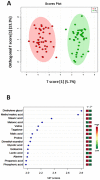
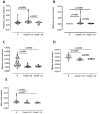
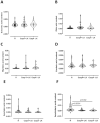
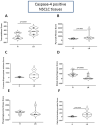
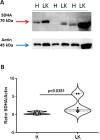
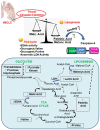
Similar articles
-
Circulating and tumor-associated caspase-4: a novel diagnostic and prognostic biomarker for non-small cell lung cancer.Oncotarget. 2018 Apr 10;9(27):19356-19367. doi: 10.18632/oncotarget.25049. eCollection 2018 Apr 10. Oncotarget. 2018. PMID: 29721208 Free PMC article.
-
Pyruvate carboxylase is critical for non-small-cell lung cancer proliferation.J Clin Invest. 2015 Feb;125(2):687-98. doi: 10.1172/JCI72873. Epub 2015 Jan 20. J Clin Invest. 2015. PMID: 25607840 Free PMC article. Clinical Trial.
-
Downregulation of N-Acetylglucosaminyltransferase GCNT3 by miR-302b-3p Decreases Non-Small Cell Lung Cancer (NSCLC) Cell Proliferation, Migration and Invasion.Cell Physiol Biochem. 2018;50(3):987-1004. doi: 10.1159/000494482. Epub 2018 Oct 24. Cell Physiol Biochem. 2018. PMID: 30355927
-
[Expression and clinical significance of caspase-3,survivin and k-ras in non-small cell lung cancer.].Zhongguo Fei Ai Za Zhi. 2008 Feb 20;11(1):90-6. doi: 10.3779/j.issn.1009-3419.2008.01.020. Zhongguo Fei Ai Za Zhi. 2008. PMID: 20727274 Chinese.
-
[Non-small cell lung cancer. New biomarkers for diagnostics and therapy].Pathologe. 2015 Nov;36 Suppl 2:189-93. doi: 10.1007/s00292-015-0084-1. Pathologe. 2015. PMID: 26391246 Review. German.
Cited by
-
Induction of Inflammation Disrupts the Negative Interplay between STING and S1P Axis That Is Observed during Physiological Conditions in the Lung.Int J Mol Sci. 2023 May 5;24(9):8303. doi: 10.3390/ijms24098303. Int J Mol Sci. 2023. PMID: 37176007 Free PMC article.
-
Identification of a novel subpopulation of Caspase-4 positive non-small cell lung Cancer patients.J Exp Clin Cancer Res. 2020 Nov 13;39(1):242. doi: 10.1186/s13046-020-01754-0. J Exp Clin Cancer Res. 2020. PMID: 33187551 Free PMC article.
-
Role of the AIM2 Inflammasome in Cancer: Potential Therapeutic Strategies.Biomedicines. 2025 Feb 6;13(2):395. doi: 10.3390/biomedicines13020395. Biomedicines. 2025. PMID: 40002808 Free PMC article. Review.
-
Metabolomic Profiling in Lung Cancer: A Systematic Review.Metabolites. 2021 Sep 17;11(9):630. doi: 10.3390/metabo11090630. Metabolites. 2021. PMID: 34564447 Free PMC article. Review.
-
Caspase-11 and AIM2 inflammasome are involved in smoking-induced COPD and lung adenocarcinoma.Oncotarget. 2021 May 25;12(11):1057-1071. doi: 10.18632/oncotarget.27964. eCollection 2021 May 25. Oncotarget. 2021. PMID: 34084280 Free PMC article.
References
-
- Najafi Z, Mohamadnia A, Ahmadi R, Mahmoudi M, Bahrami N, Khosravi A, Jamaati H, Tabarsi P, Kazem Pour Dizaji M, Shirian S. Proteomic and genomic biomarkers for Non-Small Cell Lung Cancer: Peroxiredoxin, Haptoglobin, and Alpha-1 antitrypsin. Cancer Med. 2020; 9:3974–3982. 10.1002/cam4.3019. - DOI - PMC - PubMed
LinkOut - more resources
Full Text Sources
Miscellaneous

